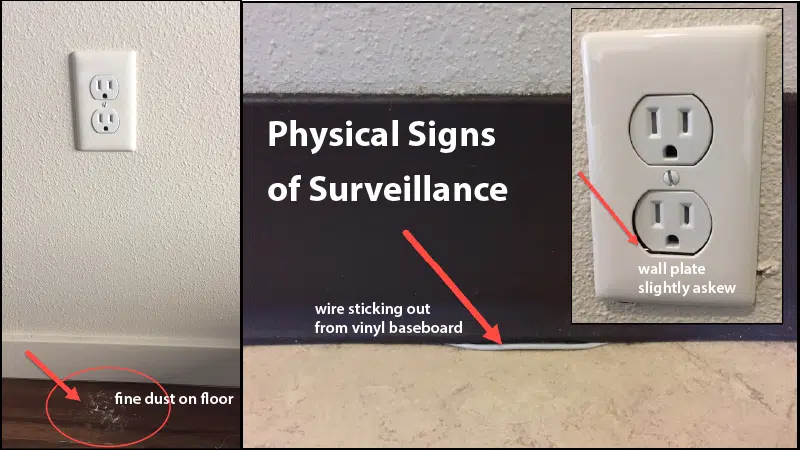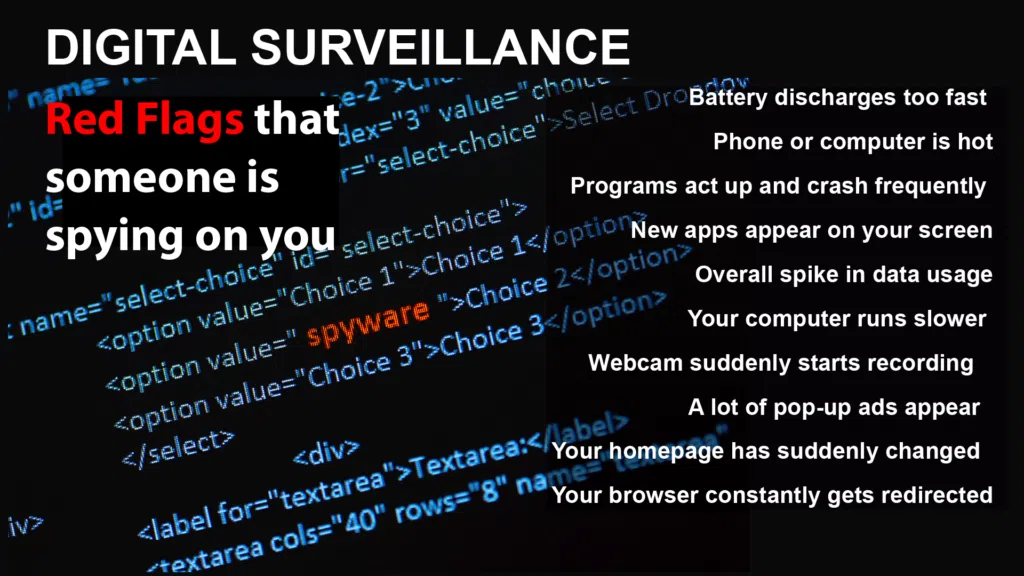Is someone spying on me?
There are countless different ways in which someone can secretly spy or eavesdrop on you. Fortunately, there are also many signs of surveillance that can uncover hidden cameras or microphones in your home, office, computer, car, or cell phone.
Some of the most obvious signs you are being spied on include:
- Someone seems to always be “bumping into you” in public. As if they always know when and where to find you.
- During divorce or separation, your ex-partner knows more details than they should about your activities, finances, or other details.
- A business competitor consistently outbids you or seems to have learned of certain trade secrets.
However, there are other common signs of surveillance as well. Read more below.

Spot Common Signs of Surveillance
We’ve put together a list of typical signs that suggest you may be being spied on to help you detect hidden cameras or microphones, or other spyware.
Common Physical Signs of Surveillance in Your Home or Office
Spy cameras and microphones are relatively inexpensive, accessible, and smaller than ever. Thus, they are also easily installed and hidden. However, while installing may be simple, people may be in a hurry and leave behind traces of their work. Perhaps you’ve already noticed a few things that don’t seem quite right.
Electrical fixture wall plates are slightly out of place.
Look for signs of disturbance. Specifically, light switches, electrical outlets, and smoke alarms are popular places for eavesdropping devices because most of the time, we don’t pay much attention to them. For example, look for debris on the floor beneath a fixture, or subtle color differences in the wall plate color. Similarly, look for gaps or poor alignment that may result from hurried installation.
Check your vinyl baseboard – where the floor and wall meet.
Another common sign of surveillance is changes in your vinyl baseboards. Frequently, spy devices require wiring for power or data transmission. Thus, the suspect must hide wires. A favorite spot is behind the vinyl baseboard. So, look for a ridge, bump, or discoloring, and then check further for hidden microphone or wiring.
Look for discoloration on ceilings and walls.
It may be very small, but a circular spot, no larger than a coin, is a signal that you are being spied on. In particular, small devices such as pinhole microphones or video cameras, rest on the other side of a ceiling or wall and may leave an impression.
A familiar item or sign in your home or office simply looks off.
Eavesdroppers try to hide devices in the least obvious place. For this reason, fixtures like lamps and clock radios that you hardly pay attention to are popular choices. A sudden change in these familiar items may be a sign of surveillance. Remember, when someone is installing a surveillance device, they are usually in a hurry and nervous. This means any item that has been affected is rarely left in the same way. Thus, look to see if any are a little crooked, or showing a strange semi-reflective surface, or even have a tiny hole.
You notice white debris close to a wall.
It stands to reason that to install a small microphone or video camera inside the wall, you must bore a hole into them. This will generally leave white dust on the ground. Someone that is nervous or in a hurry may neglect to clean up the dust. Whenever you spot white powder-like dust, you should look at that wall or ceiling for any recent disturbances.
Also, moveable ceiling tiles are ideal for hiding microphones and cameras. But, they are easily damaged when moved. Always take a closer if you see small pieces on the floor, or gouges, chips, cracks, or sagging in the tiles.
The locks on your doors become easily stuck, or just don’t feel right.
It may just need to be oiled, but when your lock suddenly becomes stiff, sticky, or even fails, it’s a strong indication that you’re being spied on. The chances are that someone picked or otherwise manipulated it to get inside and install spy devices.
Your files or belongings appear to have been disturbed or rummaged through, but there doesn’t seem to be anything missing.
Eavesdroppers often mistakenly think that items left out of sight are easily forgotten. So, when rummaging through filing cabinets, desk drawers, or dresser drawers, they are less concerned about leaving everything back the way it was. If things feel a little off and aren’t exactly as you remember them then there is every reason to be suspicious.
A clear sign you’re being spied on – new items in your home or office appear from nowhere.
Beware of new items at home or in your office. If you notice anything new, like a wall clock, phone, lamp, or even a picture frame, ask where it came from. If no one knows, it may have been planted there with a surveillance device inside it.
Other Signs Someone is Spying on You in Your Home or Office
Your home or office has been broken into, but nothing was stolen.
Logically, burglars do not break into a home and take nothing, unless they were there for another reason, like installing eavesdropping devices. They may break in several times over a prolonged period, so repeat theft-free burglaries are a clue. Notably, physical evidence may be as subtle as slightly moved furniture and table-top items. So, check for exposed imprints on rugs or carpets, or dust-rings under lamps or telephones.
We offer counter surveillance and bug sweep services for your home and office.
Beware vendors or suppliers bearing electronic gifts.
A popular tactic is to give you an alarm clock, radio, desk lamp, or almost any other type of electronic. The gift-giver may have hidden a microphone or camera, but because you know them, you don’t suspect it is bugged. Unfortunately, it is not limited to electronic gifts. Notably, desktop items like pens, calculators, and even Post-It dispensers, can house spying devices.
You receive a written or recorded copy of a private conversation you’ve had.
This is solid proof you have been under surveillance. Sometimes eavesdroppers send copies of private conversations to let you know they have something on you. This is an easy way to blackmail, intimidate, or otherwise psychologically undermine the target. This tactic is frequently used in divorce cases, civil suits, custody battles, criminal cases, to seek an advantage over the other.
Unauthorized people seem to know information about your business that should have been confidential.
The clear indication that you are being spied on is where one of your business competitors appears to have knowledge of some aspect of your company that is proprietary or sensitive. For example, your competitor might consistently out-bid you for contracts, or a third party refers to the contents of confidential company documents. They may have gained access to this information by bugging your office, telephone, or computer.
Utility company workers or servicers show up without anyone calling for them.
The oldest trick eavesdroppers pull is to pretend to be a plumber, air-con repairman, or utility company worker coming to fix a problem. Most people never question service providers, but it allows eavesdroppers to gain access to a building or office to install surveillance devices.
You notice utility or cable company vehicles parked near your home or office but with no visible occupants, or frequently carrying out “repair work” in your area.
As mentioned above, eavesdroppers often use service vans as surveillance posts to listen in on your activity. Of course, sometimes this their presence is perfectly innocent. However, an indication you’re under surveillance is if you notice the same track or van more than three times over a short time. You can contact the specific utility company to see if work is being required on your street.
Your TV starts to experience unusual interference.
As with your radio, spying devices emit signals and can interfere with your TV’s reception, particularly on UHF channels (usually channels 2, 7, 13, 14, 50-60, and 66-68). If you notice interference, this is a sign of surveillance.
Your AM/FM radio starts to experience unusual interference.
In the movies, we often blame UFOs for radio interference. But in the real world, sudden interference is more likely because someone tampered with your antennae. Interference happens when more than one electronic device shares a frequency. Since many listening devices use frequencies just inside the FM radio band, when they’re located in the same room with a radio, the radio will squeal. In this way, the radio is a bug detector because the closer it is to the device, the louder the squeal.
When your phone is hung up, you hear a tone on your phone line.
If you can hear a faint but continuous dull tone, it suggests that someone hooked up a “slave” eavesdropping device to your phone line. In this case, the chance you are being spied upon is high.
When your phone is on the hook, you hear noises coming from the handset.
A Hook Switch Bypass turns your phone’s receiver into a microphone. When installed, they create noises when your phone is on the hook. Additionally, this creates a double dilemma because it is effective within a radius of 20 feet from the phone. So, even when you’re not talking on the phone, an eavesdropper can monitor what is being said.
Unusual sounds on your telephone line, such as static, popping, or humming when you’re speaking on the phone.
Another sign of surveillance is due to wiretaps. When someone connects two conductors to form a phone tap, they create a capacitive discharge. This capacitive discharge causes noises on the phone.
Frequently, when you answer the phone, no-one is there but a faint, a high-pitched tone can be heard.
A final sign you are being spied on – hearing tones with no one on the other end. While it may just be a FAX machine calling the wrong number, several listening bugs can also be the culprit. Among the other possibilities, however, is a slave device, a line extender, an infinity transmitter, or a harmonica bug.

